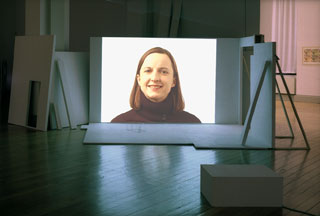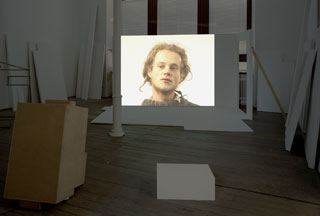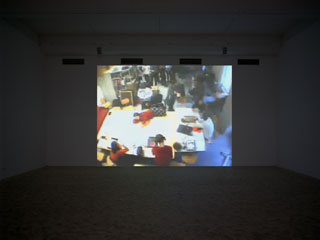// Alba D'Urbano
//

Main;
Projects() {
Esposizione Impraticabile();
Mare();
The Negated Room();
Hautnah();
Touch Me;
Stoffwechsel;
Il Sarto Immortale();
Die Wunderschöne Wunde;
Tra cielo e terra;
L'età dell'oro();
Venere;
Private Property();
Monitoraggio;
corpo_insegnante();
Natura Morta(); Redden/Erröten; Son_no;
Airbag;
Collaborations();
Net-Works();
History();
Imprint;
Venere;
//2002
 Overlifesized
portraits of young people are superimposed alternately on the projection surface
of the video “La nascita di Venere,” which dates from 2002. These
are images of artist Alba D’Urbano’s students in Intermedia Studies
at Leipzig’s Art Academy, and they are responding to questions posed
by their professor. In these conversations, structured as interviews, the
young artists are asked in turn about their self-conceptions as artists, about
their attitudes toward the art system and their positions within it, but also
about their expectations of their professor. It is of interest to observe
upon which images, projections and myths this process is based, and with which
perspectives and personal events it is associated. The focus, then, is not
on the influence of external systems, but instead on the intimate relationship
that is established between teacher and student. Also included in the video
are additional sequences taken by an observation camera affixed to the ceiling
of the class’s workroom. Visible here is the collective worktable, the
central site of artistic productivity. The elevated, almost surveillance style
perspective of the camera not only suggests the omnipresence of the absent
teaching staff, but also visualizes and interrogates the transformed structures
of teaching in light of new technologies.
Overlifesized
portraits of young people are superimposed alternately on the projection surface
of the video “La nascita di Venere,” which dates from 2002. These
are images of artist Alba D’Urbano’s students in Intermedia Studies
at Leipzig’s Art Academy, and they are responding to questions posed
by their professor. In these conversations, structured as interviews, the
young artists are asked in turn about their self-conceptions as artists, about
their attitudes toward the art system and their positions within it, but also
about their expectations of their professor. It is of interest to observe
upon which images, projections and myths this process is based, and with which
perspectives and personal events it is associated. The focus, then, is not
on the influence of external systems, but instead on the intimate relationship
that is established between teacher and student. Also included in the video
are additional sequences taken by an observation camera affixed to the ceiling
of the class’s workroom. Visible here is the collective worktable, the
central site of artistic productivity. The elevated, almost surveillance style
perspective of the camera not only suggests the omnipresence of the absent
teaching staff, but also visualizes and interrogates the transformed structures
of teaching in light of new technologies.
 With
the “Birth of Venus” of the work’s Italian title, Alba D’Urbano
directs our attention toward the hour of birth of art and of the artist respectively.
The reference to the goddess Venus as the symbol of beauty alludes to the
centuries-old tradition within occidental cultural history which regarded
the concept of art as existing in close connection with the ideal of beauty.
Artists were trained at the art academies to comply with this artistic ideal.
With the paradigm change occurring in the early 20th century, both the goals
of art and the position of the artist were redefined. In recent years, Alba
D’Urbano has been preoccupied with the effects of this shift within
contemporary art activities, and with the displacements of artistic practices
within current system of display and presentation. In this context, the focus
is on the so-called “new media” within the processes of communication
and art, but also on the teaching of art.
With
the “Birth of Venus” of the work’s Italian title, Alba D’Urbano
directs our attention toward the hour of birth of art and of the artist respectively.
The reference to the goddess Venus as the symbol of beauty alludes to the
centuries-old tradition within occidental cultural history which regarded
the concept of art as existing in close connection with the ideal of beauty.
Artists were trained at the art academies to comply with this artistic ideal.
With the paradigm change occurring in the early 20th century, both the goals
of art and the position of the artist were redefined. In recent years, Alba
D’Urbano has been preoccupied with the effects of this shift within
contemporary art activities, and with the displacements of artistic practices
within current system of display and presentation. In this context, the focus
is on the so-called “new media” within the processes of communication
and art, but also on the teaching of art.
 The
interview questions:
The
interview questions:
1. When did you decide to become an artist? Are there specific events/recollections that guided your evolution in the direction of art? Do the roots of this process perhaps lie in your childhood?
2. When and how does the idea for one of your works develop? Can you give an example?
3. What does it mean to you to be/ to become an artist? Do you want do integrate yourself into the contemporary and future art system? How do your envision your future?
4. How do you perceive the art business? Have the roles played by the actors populating the art microcosm changed in recent years? Which of these roles would you like to assume? What means would you like to use to become successful? What resources are offered by the system?
5. What is the significance of art in social life? What is its relationship to the entertainment industry and to politics? Is art socially accountable, or does it have another type of specific function?
6. What is your view of the position of the artist in contemporary society?
7. What do you expect from the Academy concerning the formation of your artistic personality, and for your future career? What do you expect from me?